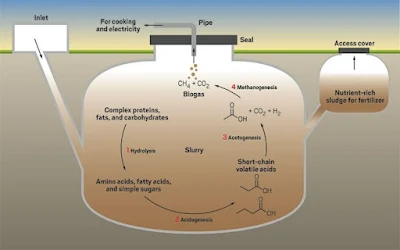Search This Blog
Friday, December 17, 2021
Sunday, August 22, 2021
Digestate or slurry from biogas digester useful as organic plant fertilizer
From waste to useful effluent as organic plant fertilizer. I noticed my chilli plant starts flowering everytime I pour the effluent to the ground below it.
It is very obvious when effluent from biogas digester used onto chilli plant, its flowers bloom significantly thrn producing lot of chillies.
How to feed a biogas digester to produce biogas
To feed a biogas system we need to know how much to put into it. Because the system is a biological one and operated by bunch of methane microbes, we need to know the background temperature where you placed the digester to determine the volume they can consume within a period of time. Too much feeding will cause sourness shows unability of the microbes to cope (overfeeding). Methane microbes activity will only work in optimum within a narrow pH window like 6-8. So the amount of feed is very critical to maintain the system in a balance easily control by looking at pH. I am very lucky able to find temperature data at my place. The average is like 26.8 celcius. So, according to David David William House 's graph (look below), the approximate HRT* is 45 days. So, it is safer for me to decide to choose 50 days HRT for my digester. To determine how much to feed daily is by calculating = digester volume (liter) / HRT (day) = 200 liter/50 days = 4 liter/day. Again, rule of thumb do not get solid food waste over 50% of daily feeding volume. In my case for 4 liter feeding, 2 kg of food waste is the maximum volume then mix with 2 liter of water to a total of 4 liter. If you do not have confident and do not want to get your system sour lets try less than 50% food waste of your daily feeding volume. Please try and error, experiment with your system and you will learn a lot finding the most optimum condition to run your system.
HRT - hydraulic retention time
HRT indicates the number of days required for a given amount of digestion to occur at a specified temperature. The general idea is that the colder things are, the longer things take. Of course, it could therefore also represent the size of the digester needed for a given amount of daily feedstock, since that daily amount will have to stay in the digester an approximate number of days, the digester will be correspondingly larger as the average temperature drops.
Source of graph - DIY Home Biogas Digester: How to make biogas at home manual by David William House is worth to try (diybiogasgenerator.blogspot.com)
How to operate a small scale biogas digester system

Friday, April 17, 2020
Design and construction of mini biogas digester for family use
1. Biogas production of 2m3/day is good enough for a family
2. It is a DIY kit small scale biogas system for convenient transport and easy assembly.
3. It is surface mounted, there is no need for digging or heavy construction.
4. It can be assembled within 2 hours by anyone with manual and video guidance.
5. Treated organic waste locally, use biogas for cooking, electricity or feed garden with nutritious liquid fertilizer.
6. Used for family, farm, restaurant, hotel, resort to treat organic waste, such as food waste, sewage sludge, animal waste.
7. Light weight and easy to install, packed in carton box.
8. Life span more than 10 years - made of stainless steel frame
9. Raw material of green house and PVC biogas storage bag
10. Specification 156*120*195cm
11. Methane Content 65% which is excellent for cooking
- Construction video:






